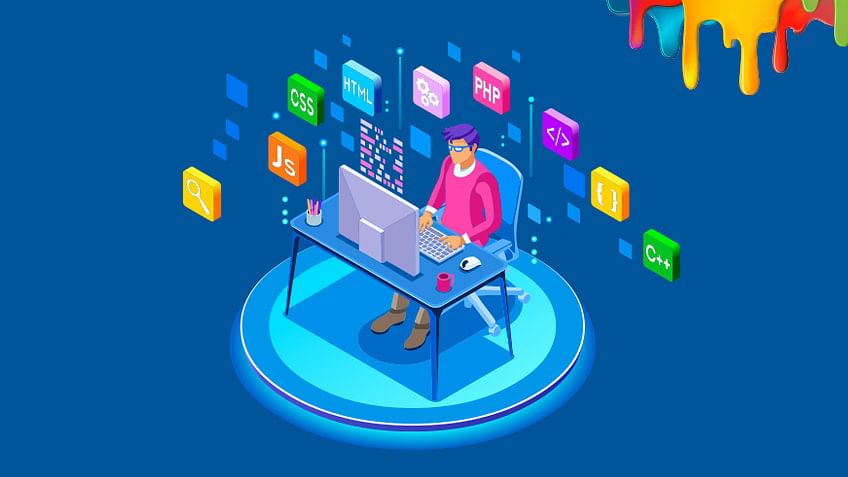In today’s fast-evolving tech world, the demand for full-stack developers is soaring. Full-stack...
How to Become a Full-Stack Web Developer: A Complete Guide?
In today’s tech-driven world, full-stack web developers are in high demand. They possess the skills to work on both the front-end and back-end of web applications, making them versatile and valuable assets to any development team. If you're looking to become a full-stack web developer, this guide will take you through the steps, skills, and resources you need to kickstart your journey.
1. Understand the Role of a Full-Stack Developer
A full-stack developer is someone who is proficient in both front-end and back-end development. They can handle all aspects of a web application, from designing user interfaces to managing servers and databases.
- Front-End Development: Involves creating the visual part of the website that users interact with. This includes working with HTML, CSS, JavaScript, and frameworks like React, Angular, or Vue.js.
- Back-End Development: Involves managing the server, database, and application logic. This typically requires knowledge of languages like Node.js, Python, Ruby, or PHP, and working with databases like MySQL, MongoDB, or PostgreSQL.
2. Learn the Basics of Web Development
Before diving into full-stack development, it’s essential to understand the basics of web development.
- HTML/CSS: Start with learning HTML for structuring web pages and CSS for styling them. This forms the foundation of any web development project.
- JavaScript: Master JavaScript to make your websites interactive. JavaScript is essential for both front-end and back-end development.
3. Choose Your Technology Stack
A technology stack is a set of tools and technologies used to develop a web application. Here are some popular stacks:
- MERN Stack: MongoDB, Express.js, React, Node.js
- MEAN Stack: MongoDB, Express.js, Angular, Node.js
- LAMP Stack: Linux, Apache, MySQL, PHP
- Django Stack: Python, Django, PostgreSQL
Choose a stack based on your interest and the type of projects you want to work on.
4. Master Front-End Development
Once you have a good grasp of the basics, move on to mastering front-end development.
- Learn CSS Frameworks: Familiarize yourself with CSS frameworks like Bootstrap or Tailwind CSS to speed up your development process.
- JavaScript Frameworks/Libraries: Master one or more JavaScript libraries or frameworks like React.js, Angular, or Vue.js.
5. Master Back-End Development
Next, focus on the back-end part of web development.
- Choose a Back-End Language: Learn a back-end language like Node.js (JavaScript), Python, Ruby, or PHP. Start by understanding the basics, and then move on to advanced concepts like API development and authentication.
- Learn Databases: Understand how to work with databases. Start with SQL databases like MySQL or PostgreSQL and then move to NoSQL databases like MongoDB.
6. Version Control with Git
Git is a version control system that tracks changes in your code. It’s essential for collaborative development and managing project versions.
- Learn Git Commands: Familiarize yourself with basic Git commands like
git clone,git commit,git push, andgit pull. - Use GitHub/GitLab: Host your projects on platforms like GitHub or GitLab. This not only helps in version control but also serves as a portfolio to showcase your work.
7. Understand APIs and RESTful Services
APIs (Application Programming Interfaces) are crucial for connecting different parts of your web application.
- Learn RESTful APIs: Understand how to create and consume RESTful APIs, which are commonly used for web services.
- Work with JSON: Get comfortable with JSON (JavaScript Object Notation), the standard format for data exchange in web development.
8. Build Projects
Learning theory is important, but hands-on experience is what makes you a full-stack developer.
- Start with Small Projects: Begin with small projects like a personal blog, a to-do list app, or a portfolio website.
- Work on Real-World Projects: As you gain confidence, move on to more complex projects like an e-commerce site, a social media platform, or a content management system (CMS).
9. Deploy Your Applications
Learn how to deploy your applications so they can be accessed by users.
- Use Hosting Platforms: Start with platforms like Heroku, Vercel, or Netlify for deploying your applications.
- Understand Cloud Services: Get familiar with cloud platforms like AWS, Google Cloud, or Azure for more complex deployments.
10. Keep Learning and Stay Updated
The tech industry evolves rapidly, so it’s crucial to stay updated with the latest trends and technologies.
- Follow Blogs and Tutorials: Subscribe to blogs, follow tutorials, and join communities like Stack Overflow, GitHub, or Reddit.
- Take Advanced Courses: Once you're comfortable with the basics, consider taking advanced courses in full-stack development, cloud computing, or DevOps.
Conclusion
Becoming a full-stack web developer is a rewarding journey that requires dedication, practice, and continuous learning. Start by mastering the basics, choose your technology stack, and gradually build your skills through hands-on projects. As you gain experience, you’ll be ready to tackle complex web applications and become a sought-after professional in the tech industry. To accelerate your learning, consider enrolling in an Online Full Stack Course that offers structured guidance, expert mentorship, and practical projects. This will not only help you build a solid foundation but also keep you updated with the latest trends. Remember, the key to success is persistence and the willingness to learn.


